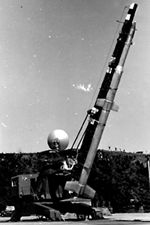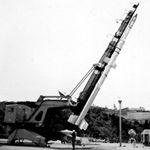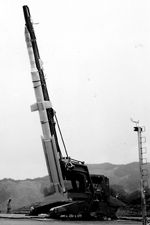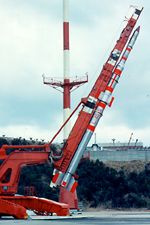The Challenge of Japan's First Satellite
 When
the Mu project started, it was a sounding rocket project which aimed at
the outer Van Allen Belt. But an artificial satellite plan that had been
under discussion since 1961-62 gradually created a bigger sensation among
space scientists. At last, a scientific satellite project using M rockets
became ready for realization. At the same time, the L-4S project started
as a precursor project to simulate the payload injection scheme for the
MU project. When
the Mu project started, it was a sounding rocket project which aimed at
the outer Van Allen Belt. But an artificial satellite plan that had been
under discussion since 1961-62 gradually created a bigger sensation among
space scientists. At last, a scientific satellite project using M rockets
became ready for realization. At the same time, the L-4S project started
as a precursor project to simulate the payload injection scheme for the
MU project.
The L-4S rocket is a four-stage, solid propellant rocket.
To give a last push to the payload, the L-4S was equipped with a fourth
kick stage on a three-stage L-3H sounding rocket. But ISAS faced a great
deal of difficulties in sending the first Japanese satellite into orbit.
In February, 1970, the fifth attempt succeeded in sending a 24 kg payload
into an elliptical orbit around the earth. There follows a short history
of the birth of the first Japanese satellite OHSUMI.
 |
L-4S-1
The 1st and 2nd stage trajectories were normal. But the 3rd stage
trajectory became erratic by 10' upward and 20' northward, and went
beyond the communication range after 4th stage ignition. In the meantime,
a despin motor did not operate and the attitude control was not carried
out. The abnormality of the 3rd stage was attributed to the imperfect
separation of the 3rd stage from the 2nd stage. As something wrong
occurred in the power supply system during the 2nd stage motor burning,
a command to stop the despin motor ignition must have been generated. |
 |
L-4S-2
The 1st, 2nd and 3rd stage trajectories were normal. Though the despin
motor did not operate perfectly and 1.6 Hz spin was left, the attitude
control could direct the longitudinal axis within 1°-3° error.
The command wave to shift the ignition time of the kick stage was
sent successfully, but the kick motor was not ignited. Post-flight
analysis revealed that the connection between the kick stage and the
control system was out of joint due to unexpectedly great torque during
despin phase. It caused the kick stage ignition to be unsuccessful. |
 |
L-4S-3
The 1st and 2nd stages flew normally, but the 3rd stage ignition was
unsuccessful and the kick motor ignition was prevented by safety operation
command. The unsuccessful ignition was caused by disconnection again.
The connection was thought not to be strong enough against the load
at the time of 1st stage separation. |
 |
L-4T-1
After the launch of L-4S-3, all the launch operations were stopped
from spring of 1967 to summer of 1968 due to the fishermen's problem.
Meanwhile, efforts to improve the L-4S continued. The launch of L-4T-1
was planned to verify the results of these efforts. As the propellant
of the last stage was reduced to 60 percent, L-4T-1 was planned not
to inject its payload into orbit. The 1st, 2nd and 3rd stage trajectories
were normal, but after separation, the 3rd stage collided twice with
the upper stage from behind. As the collisions occurred near the center
of gravity, however, induced attitude dispersion was small and the
attitude control of the last stage was carried out perfectly. The
flight of the last stage was normal and it fell in the middle of the
Pacific Ocean. The collision was caused by residual thrust of the
separated 3rd stage motor. |
 |
L-4S-4
Everything went well up to the satisfactory attitude control of the
3rd stage. Once again, however, the 3rd stage collided with the upper
stage from behind. The collision caused a large dispersion in the
attitude of the upper stage, which flew off northeast after kick-stage
ignition with the attitude unrestrored by the attitude control system. |
 |
L-4S-5
was launched in February 11, 1970. Everything proceeded to plan, and
the satellite was injected into elliptical orbit with the apogee of
5,150 km and the perigee of 335 km. Thus was born the first Japanese
satellite, later renamed OHSUMI after the launch site location. It
carried little apart from accelerometers and thermometers, but it
paved the way for all future space research in Japan. |
|


|
|